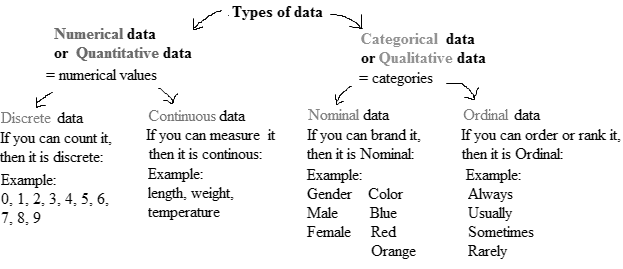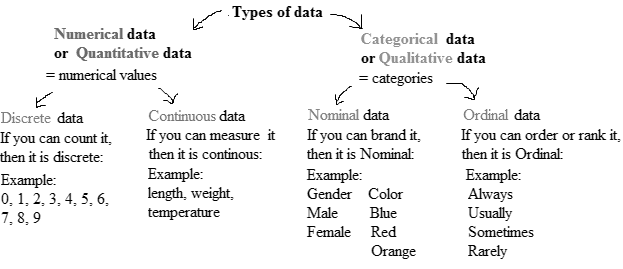
At the movies: The following table provides information about the top grossing movies of all time.


- Which of the columns represent qualitative variables?
- Which of the columns represent quantitative variables?
- Which of the columns represent nominal variables?
- Which of the columns represent ordinal variables?
a.
To identify:the columns that represent qualitative variables.
Answer to Problem 48E
The columns Movie Title and Genre represent qualitative variables.
Explanation of Solution
Given information:
| Movie Title | Release Year | Genre | Ticket Sales (millions of $) | Running Time (minutes) |
| 1. Star Wars Episode VII: The Force Awakens | 2015 | Adventure | 936 | 136 |
| 2. Avatars | 2009 | Action | 761 | 162 |
| 3. Titanic | 1997 | Historical Fiction | 659 | 194 |
| 4. Jurassic World | 2015 | Action | 652 | 124 |
| 5. The Avengers | 2012 | Adventure | 623 | 143 |
| 6. The Dark Knight | 2008 | Action | 533 | 152 |
| 7. Star Wars Episode I: The Phantom Menace | 1999 | Adventure | 475 | 133 |
| 8. Star Wars Episode IV: A New Hope | 1977 | Adventure | 461 | 119 |
| 9. Avengers: Age of Ultron | 2015 | Action | 459 | 141 |
| 10. The Dark Knight | 2012 | Action | 448 | 164 |
Concept Involved:
There are various methods of collecting information by sampling. Once the information has been collected, the collection is called a data set. Variables can be divided into two types: qualitative and quantitative. Qualitative variables are also called categorical variable, classify individuals into categories. Quantitative variables are numerical and tell how much of something there is.
Qualitative variables come in two types: ordinal variables and nominal variables.
Ordinal variables are qualitative variables whose categories have a natural ordering.
Nominal variables are qualitative variables whose categories have no natural ordering.
Quantitative variables can be either discrete or continuous.
Discrete variables are those whose possible values can be listed. Often, discrete variables result from counting something, so the possible values of the variable are 0, 1, 2 and so forth.
Continuous variables can, in principle, take on any value within some interval.

The variable which classifies individuals into categories is called qualitative variable, and the variable which provide information about quantity or number of something is quantitative variable. The Movie Title and Genre classifies the top grossing movies of all time.
Therefore, the columns Movie Title and Genre represent qualitative variables.
b.
To identify:the columns that represent quantitative variables.
Answer to Problem 48E
The columns Ticket Sales (millions of $) and Running Time (minutes) represent quantitative variables.
Explanation of Solution
Given information:
| Movie Title | Release Year | Genre | Ticket Sales (millions of $) | Running Time (minutes) |
| 1. Star Wars Episode VII: The Force Awakens | 2015 | Adventure | 936 | 136 |
| 2. Avatars | 2009 | Action | 761 | 162 |
| 3. Titanic | 1997 | Historical Fiction | 659 | 194 |
| 4. Jurassic World | 2015 | Action | 652 | 124 |
| 5. The Avengers | 2012 | Adventure | 623 | 143 |
| 6. The Dark Knight | 2008 | Action | 533 | 152 |
| 7. Star Wars Episode I: The Phantom Menace | 1999 | Adventure | 475 | 133 |
| 8. Star Wars Episode IV: A New Hope | 1977 | Adventure | 461 | 119 |
| 9. Avengers: Age of Ultron | 2015 | Action | 459 | 141 |
| 10. The Dark Knight | 2012 | Action | 448 | 164 |
Concept Involved:
There are various methods of collecting information by sampling. Once the information has been collected, the collection is called a data set. Variables can be divided into two types: qualitative and quantitative. Qualitative variables are also called categorical variable, classify individuals into categories. Quantitative variables are numerical and tell how much of something there is.
Qualitative variables come in two types: ordinal variables and nominal variables.
Ordinal variables are qualitative variables whose categories have a natural ordering.
Nominal variables are qualitative variables whose categories have no natural ordering.
Quantitative variables can be either discrete or continuous.
Discrete variables are those whose possible values can be listed. Often, discrete variables result from counting something, so the possible values of the variable are 0, 1, 2 and so forth.
Continuous variables can, in principle, take on any value within some interval.

The variable which classifies individuals into categories is called qualitative variable, and the variable which provide information about quantity or number of something is quantitative variable. The Tickets Sales (millions of $) and Running Time (minutes) represent how many of something of there is present.
Therefore, these columns represents quantitative variable.
c.
To identify:the columns that represent nominal variables.
Answer to Problem 48E
The columns Genre represent nominal variables.
Explanation of Solution
Given information:
| Movie Title | Release Year | Genre | Ticket Sales (millions of $) | Running Time (minutes) |
| 1. Star Wars Episode VII: The Force Awakens | 2015 | Adventure | 936 | 136 |
| 2. Avatars | 2009 | Action | 761 | 162 |
| 3. Titanic | 1997 | Historical Fiction | 659 | 194 |
| 4. Jurassic World | 2015 | Action | 652 | 124 |
| 5. The Avengers | 2012 | Adventure | 623 | 143 |
| 6. The Dark Knight | 2008 | Action | 533 | 152 |
| 7. Star Wars Episode I: The Phantom Menace | 1999 | Adventure | 475 | 133 |
| 8. Star Wars Episode IV: A New Hope | 1977 | Adventure | 461 | 119 |
| 9. Avengers: Age of Ultron | 2015 | Action | 459 | 141 |
| 10. The Dark Knight | 2012 | Action | 448 | 164 |
Concept Involved:
There are various methods of collecting information by sampling. Once the information has been collected, the collection is called a data set. Variables can be divided into two types: qualitative and quantitative. Qualitative variables are also called categorical variable, classify individuals into categories. Quantitative variables are numerical and tell how much of something there is.
Qualitative variables come in two types: ordinal variables and nominal variables.
Ordinal variables are qualitative variables whose categories have a natural ordering.
Nominal variables are qualitative variables whose categories have no natural ordering.
Quantitative variables can be either discrete or continuous.
Discrete variables are those whose possible values can be listed. Often, discrete variables result from counting something, so the possible values of the variable are 0, 1, 2 and so forth.
Continuous variables can, in principle, take on any value within some interval.

The values are classified into categories in a nominal variable, but no natural ordering is there in categories, whereas, the values are also classified into categories in an ordinary variable but a natural ordering is there in categories.
Therefore, the Genre column has categories but doesn’t have natural ordering.
d.
To identify:the columns that represent ordinal variables.
Answer to Problem 48E
The column Movie Title represent ordinal variables.
Explanation of Solution
Given information:
| Movie Title | Release Year | Genre | Ticket Sales (millions of $) | Running Time (minutes) |
| 1. Star Wars Episode VII: The Force Awakens | 2015 | Adventure | 936 | 136 |
| 2. Avatars | 2009 | Action | 761 | 162 |
| 3. Titanic | 1997 | Historical Fiction | 659 | 194 |
| 4. Jurassic World | 2015 | Action | 652 | 124 |
| 5. The Avengers | 2012 | Adventure | 623 | 143 |
| 6. The Dark Knight | 2008 | Action | 533 | 152 |
| 7. Star Wars Episode I: The Phantom Menace | 1999 | Adventure | 475 | 133 |
| 8. Star Wars Episode IV: A New Hope | 1977 | Adventure | 461 | 119 |
| 9. Avengers: Age of Ultron | 2015 | Action | 459 | 141 |
| 10. The Dark Knight | 2012 | Action | 448 | 164 |
Concept Involved:
There are various methods of collecting information by sampling. Once the information has been collected, the collection is called a data set. Variables can be divided into two types: qualitative and quantitative. Qualitative variables are also called categorical variable, classify individuals into categories. Quantitative variables are numerical and tell how much of something there is.
Qualitative variables come in two types: ordinal variables and nominal variables.
Ordinal variables are qualitative variables whose categories have a natural ordering.
Nominal variables are qualitative variables whose categories have no natural ordering.
Quantitative variables can be either discrete or continuous.
Discrete variables are those whose possible values can be listed. Often, discrete variables result from counting something, so the possible values of the variable are 0, 1, 2 and so forth.
Continuous variables can, in principle, take on any value within some interval.

The values are classified into categories in a nominal variable, but no natural ordering is there in categories, whereas, the values are also classified into categories in an ordinary variable but a natural ordering is there in categories. The variable movie title classifies the top grossing movies of all time.
Therefore, column Movie Title represents ordinal variables.
Want to see more full solutions like this?
Chapter 1 Solutions
ELEMENTARY STATISTICS-ALEKS ACCESS CODE
 Glencoe Algebra 1, Student Edition, 9780079039897...AlgebraISBN:9780079039897Author:CarterPublisher:McGraw Hill
Glencoe Algebra 1, Student Edition, 9780079039897...AlgebraISBN:9780079039897Author:CarterPublisher:McGraw Hill Big Ideas Math A Bridge To Success Algebra 1: Stu...AlgebraISBN:9781680331141Author:HOUGHTON MIFFLIN HARCOURTPublisher:Houghton Mifflin Harcourt
Big Ideas Math A Bridge To Success Algebra 1: Stu...AlgebraISBN:9781680331141Author:HOUGHTON MIFFLIN HARCOURTPublisher:Houghton Mifflin Harcourt Holt Mcdougal Larson Pre-algebra: Student Edition...AlgebraISBN:9780547587776Author:HOLT MCDOUGALPublisher:HOLT MCDOUGAL
Holt Mcdougal Larson Pre-algebra: Student Edition...AlgebraISBN:9780547587776Author:HOLT MCDOUGALPublisher:HOLT MCDOUGAL
 Functions and Change: A Modeling Approach to Coll...AlgebraISBN:9781337111348Author:Bruce Crauder, Benny Evans, Alan NoellPublisher:Cengage Learning
Functions and Change: A Modeling Approach to Coll...AlgebraISBN:9781337111348Author:Bruce Crauder, Benny Evans, Alan NoellPublisher:Cengage Learning




